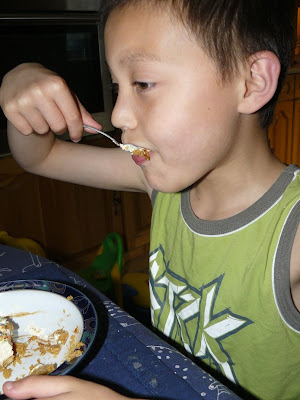First I cut two bag pieces measuring 16.5 inches x 14 inches from the plain tablecloth. I also cut two strips of a contrasting fabric measuring 14 inches x 2 inches. These would form the casing for the cord. As my main fabric was very plain, I decided to liven it up a little by adding a length of printed ribbon to each side of the bag. I found a roll of this really colourful and cute wire-edge woven ribbon. The ribbon is approximately 1.75 inches wide. I cut two pieces of ribbon roughly 15 inches long and with some tweezers, carefully pulled the thin wire out from each edge. Here are my pieces of fabric and the ribbon I used.

You don’t have to use ribbon, you can use any printed fabric. You can use scraps or perhaps even strips from a jelly roll. Just turn down a ¼ (quarter) inch hem on each side before you stitch it down onto your main fabric.
I positioned my ribbon pieces about 5 inches from the bottom of each of the bag pieces. Instead of using pins to hold the ribbon in place, I used a smidgeon of fabric spray adhesive. I then stitched the ribbons to the bag pieces. I used a straight stitch and over the top of that, I ran a zig-zag stitch all the way along for decorative purposes.

Next I sewed the two narrow strips for the casing together at the narrow ends, ironed the seams open and set the resulting fabric loop aside for the time being.

I pinned the bag pieces right sides together, making sure that the ribbon edges line up. I then used my tailors’ chalk and made a mark ½ (half) inch down from the top edge. I then made a second mark ¾ (three quarters) inch down from my first mark. When you are sewing the bag pieces together, you want to leave the gap between the first and second chalk marks unstitched. I marked my stitching line in chalk (see the right picture below) to show you where the stitches would go and the gaps too. I first saw this method when Anna from Noodlehead used it in constructing her drawstring backpack.

As I wasn’t going to line this bag, I wanted to keep my edges tidy. So I pinked the excess fabric from the seam allowances but left the top inch un-pinked. This will keep a tidy edge where the opening for your casing would be once you iron it flat. This is also the part which would be covered up by the casing. I also clipped the corners.

I ironed the seam open at the top of the bag where I had left the gap in the stitching. Whilst I had the iron hot, I ironed on 4 scraps of 2 inch x 2 inch fusible interfacing - one on each side of both bottom corners. This is needed later on when making the anchor points for my drawstring cords.

I turned the bag right side out. Remember those casing strips earlier? With wrong side up, I slid the loop of fabric onto the bag. Both right sides of fabric were facing together now. I matched the side seams, pinned and stitched ½ (half) inch from the top edge.

See the hole for the cord to go through?
I folded the casing over and pressed a ¼ (quarter) inch under.

I ironed the casing so it sat flat around the top edge of the bag. I then sewed the casing down.

Using the automatic buttonhole function on my sewing machine, I sewed a button hole at each of the bottom corners of the bag as anchor points for my drawstring cords. I used a pin to mark the top of the button hole, pushing it across the buttonhole width ways and then cut the button hole open with my seam ripper. The shank of the needle stops my seam ripper from going beyond that point.

If you’re not comfortable making buttonholes with your sewing machine, there are other ways of anchoring the drawstring cords. For example, Mama Urchin uses metal grommits on her drawstring backpacks. Anna from Noodlehead uses little sewn in tabs as anchor points.
I have this nifty little bodkin which looks like a pair of tweezers with a tiny ring on it. It’s fantastic for gripping the ends of cord or wide elastic. Neat huh?

Gripping the end of my cord with my bodkin, I feed the cord through the opening, starting with one side then going through the both openings on the opposite side, and making my way back to the other opening on the first side. By doing this, I’ve made my cord go a full circle. I repeated this with other piece of cord starting at the opposite side. When finished, I had two tails coming from each side. I fed one end through the button hole on one side and made a knot. I repeated the same thing on the other side.

Here is my finished drawstring backpack.

And here is the casing which holds the cords.

If you want to make a fully lined drawstring backpack, have a look at Anna’s awesome tutorial here.
I reckon with a bit of careful planning and cutting, I can get 8 or 9 of these backpacks from each of my old corporate tablecloths. I’m hoping that they will find new homes with several young children this coming Christmas and I also hope that the fun printed ribbons will make the children very happy.




























